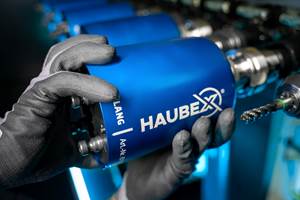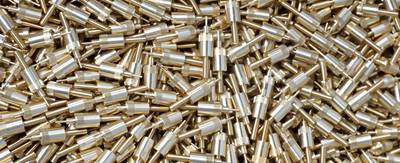Share




MetalQuest is a precision manufacturer and internal FANUC integrator that recently added its first cell with a 3D vision system. The cell machines castings, which arrive at the cell in boxes from the foundry. All photos provided by MetalQuest Unlimited Inc.
“Bin picking is basically the Holy Grail of robotic automation,” says Scott Harms, president of MetalQuest Unlimited Inc. For a human, bin-picking is often non-ergonomic, especially when parts are heavy, leading to carpal tunnel and other repetitive-use injuries. It also tends to be dull work. “People that are doing it can get burned out relatively rapidly,” he adds. However, this task has proved challenging to automate because it requires 3D vision. And according to Harms, “Vision is the ultimate complexity when it comes to robotics.”
Harms’ company, MetalQuest, is not only a manufacturer of precision machined components with locations in Nebraska and Idaho, it’s an authorized internal FANUC integrator. The shop recently tackled the challenge of automating bin picking head-on by implementing its first 3D vision system from FANUC. According to Harms, integrating an automation cell with 3D vision is “more than twice as complex” as a 2D vision system, but automating this task has been beneficial to the company’s culture.
The vision system is mounted on a gantry above the boxes, and provides the robotic arms with data that enables the robot to pick up castings regardless of where they are in the box and how they’re oriented. Humans no longer need to remove each eight-pound casting from the box and place them on a tray or conveyor.
Casting Call
The part the new cell makes starts with a casting. “These parts are literally dumped into a box at the foundry,” Harms explains. When they arrive, they’re all at different angles in the box, slanted in different ways. Traditionally, getting these castings into an automation cell would require an operator to move the eight-pound casting from the box and place it onto a tray or conveyor so a robot can pick it up and load it into a machine tool. These castings are not symmetrical, leading to further complexity — they typically need to be oriented in a certain way for a robot to pick them up and load them into the machine.
A 3D vision system enables a robot to pick up castings directly from this box. Now, the operator pushes a box of castings to each of the cell’s two stations. A 3D vision system mounted on a gantry scans one of the boxes and gives a nearby robot positional information on where the castings are located and how they’re oriented. If the vision system can’t identify any castings that are oriented in a way the robot can grab, it tells the robot to run what’s called a “stir routine,” where the robot moves the parts around in the box until some of them are reoriented in a way it can grab. The system works through one box at a time, at which point an air cylinder slides the vision system over to the other box and works through that. When both boxes are empty, an alarm sounds, notifying operators to bring over more boxes of castings.
After the robot has picked up a casting, the 3D vision system verifies the part and gives the robot more information on the casting’s orientation and how it was picked up. The top and bottom of the casting are not symmetrical, and it needs to be oriented correctly when it goes into the machine tool, so the robot sets the casting in a regrip station with a 2D vision system. This system tells the robot which side of the casting is on top and reorients it if necessary.
Then the robot sets the castings into a load station, where the second and third robots can pick it up and perform foreign object detection on the casting. These castings are made using cores, so there’s a risk of material such as excess cast iron or deburring media getting trapped inside. “We've got these very expensive tools that go into these ports and it's really important that those holes be there,” Harms explains. “When they're not, very bad things happen.” The robots have fingers that go inside the casting and confirm it’s clear. If the robot does find debris in the casting, it sets the casting off to the side and moves on to the next one, though Harms notes that this doesn’t happen often. The second and third robots load the castings into one of three Okuma HMCs, and unload them when the machining cycle is finished, placing them onto a rack where operators prepare the finished parts for shipping.
The robot then verifies the casting, reorients it if necessary in a regrip station, and sets it into a load station. Another robot picks up the casting, performs foreign object testing, then loads it into an Okuma HMC for machining.
Adding Another Dimension
According to Harms, implementing the 3D vision system was significantly more challenging than implementing a 2D vision system, which MetalQuest has extensive experience with (in fact, it was a component of the first cell the company implemented in 2011).
To prepare for this new technology, the company sent several employees to FANUC headquarters for training on implementing 3D vision systems. Employees also learned a lot on their own. “There was a lot of trial and error involved,” Harms notes.
The robot’s movement as a result of the extra dimension of vision makes this application very complex. Harms points out that when a robot picks parts off a tray or conveyor, the Z-height the robot travels is fixed. When picking parts out of a box, the Z-height changes as the box empties. Furthermore, the robot has to figure out how to work around other parts in the box, and reach all four corners. “It has to recognize the surfaces that it is programmed to pick off of,” he explains, “and then it has to articulate in a way to make its end effector parallel to the surfaces it needs to pick off of.”
End effectors also have different considerations in 3D vision applications versus ones with 2D vision. Harms says that end effectors for 2D vision systems are typically basic and straightforward, while 3D vision systems need end effectors that are more streamlined and can maneuver around other objects (in this case, the other castings in the box). The robot with the 3D vision system uses a magnetic end effector from Magswitch.

The cell runs unattended during overnight shifts, though not literally “lights out” due to the vision system’s need for light. Tool life management and tool load software from Okuma help prevent crashes and other issues during unattended machining.
Running Lights Out, But Not Actually
According to Harms, this cell can run for hours unattended. “We designed this thing to run a full shift without user intervention,” Harms says. The cell even runs lights-out, though not in the literal sense of the term. “You literally leave the lights on,” he explains. MetalQuest has LED lights on its shop floor, which emit certain light patterns. These light patterns need to stay consistent for the 3D vision system to work. “Otherwise you're screwing up the eyes of the vision systems, if that makes sense,” he says.
This consistent extra run time makes up for the fact that the cell actually moves slower than a human. The cell can keep running where humans need to take breaks and go home at the end of the shift.
Process Control
As with any automation cell, process control plays a key element in its success. Harms notes that everything from fixturing to chip control needs to be taken into account.
One aspect Harms highlights is tooling. Because this cell deals with castings that might have foreign objects inside that could potentially damage a cutting tool or a machine, it’s vital for the shop to detect abnormalities in cutting tool forces and stop the machine if it detects something unusual. “You have to use quality cutting tools and you have to get consistent life out of them,” he says. Additionally, the shop uses tool management software and tool breakage detection on its machines. MetalQuest uses Tool Life Management and Cutting Status Monitor from its machine tool supplier, Okuma.
Automation is an important element of MetalQuest’s culture. By freeing employees from physically changing and monotonous tasks, they’re free to take on more interesting and higher-value work.
Automation Impacts
Harms says the biggest impact of this cell has been on its employees, who are now freed from a physically challenging and mentally monotonous task. “Culture is so very important to us,” he says, and automation plays a key role in the culture at MetalQuest. “The people we have typically embrace something like this because it’s a job that they don't really want to do and it's being automated,” he adds.
However, Harms also cautions that companies should never approach automation with the intention of replacing people. Instead, companies should look for tasks that will make employees’ jobs more enjoyable. “We've just changed the roles and responsibilities of our people,” he explains. “Instead of loading the machine itself, they're making sure the robot has what it needs to do its job and the entire process itself is functioning as it's supposed to be.”
Seeing Into the Future
According to Harms, 3D vision and robotics is a bit of a work in progress. For now, it’s best suited to high-volume work. “There's just too much refinement and there's too much process you have to put in place,” he explains. “Everything is down to pixels, so the system is looking at all these pixels and trying to translate them into known shapes, and then it has to convert that to geometric data the robot can use.” The time and effort required to set up the system’s hardware and software is prohibitive for lower volumes. But Harms expects that won’t be the case indefinitely. “It's definitely an evolving technology,” he adds.
Related Content
Same Headcount, Double the Sales: Successful Job Shop Automation
Doubling sales requires more than just robots. Pro Products’ staff works in tandem with robots, performing inspection and other value-added activities.
Read More4 Steps to a Cobot Culture: How Thyssenkrupp Bilstein Has Answered Staffing Shortages With Economical Automation
Safe, economical automation using collaborative robots can transform a manufacturing facility and overcome staffing shortfalls, but it takes additional investment and a systemized approach to automation in order to realize this change.
Read MoreHow to Accelerate Robotic Deburring & Automated Material Removal
Pairing automation with air-driven motors that push cutting tool speeds up to 65,000 RPM with no duty cycle can dramatically improve throughput and improve finishing.
Read MoreUsing the Toolchanger to Automate Production
Taking advantage of a feature that’s already on the machine tool, Lang’s Haubex system uses the toolchanger to move and store parts, making it an easy-to-use and cost-effective automation solution.
Read MoreRead Next
CNC Machine Shop Reaps Benefits of Hiring an IT Person
A database guru combined off-the-shelf technology with an elaborate proprietary shop management software to drive efficiency throughout all areas of a machine shop.
Read MoreMetalQuest - Robotic Automation of a Machine Shop
Robots have helped MetalQuest stay competitive and deal with the skills gap. See how they have integrated high-level automation into all aspects of their shop.
Read MoreReinventing a Precision Shop With a Data-Driven Mindset
When this machine shop lost 90% of its business within three months, a reinvention was in order. Here's how it survived after quickly falling on hard times.
Read More





































